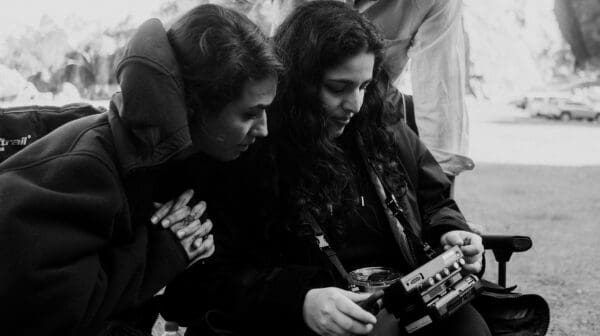
Finding New Spaces Together
‘Vádye Eshgh (The Valley of Love)’ is a collaboration between Second Generation Collective and Abdul-Rahman Abdullah weaving through themes of beauty, diversity and the rebuilding of identity.

Amala GROOM, Does she know the Revolution is coming? 2017, 2 channel digital video, 9m 56s, dimensions variable, image credit: Production still, courtesy of the artist. Does she know the Revolution is coming?, Canberra Contemporary Art Space, ACT curated by David Broker. Exhibition dates: 13 July – 8 Sept 2018.
Wiradjuri artist Amala Groom spent five years advocating for First Peoples’ rights and freedoms at the United Nations in New York and Geneva.
During her last trip to New York in 2015, Groom shared a conversation with the wife of a former Australian Prime Minister who asked what she did for a job. Groom replied by identifying herself as a maker of political art. “Have you seen my Emily?” responded the ex-PM’s wife.
The woman was referring to a painting by Emily Kame Kngwarreye, but she was implying a sense of ownership of the work of the late Anmatyerre artist, who died in 1996, while reducing her identity to a singular Western name.
Groom tells Art Guide Australia the question left her in shock, “It made me feel she was asserting her authority via a perceived ownership of Aboriginal culture to give the appearance of being sophisticated.”
A few minutes of remembered dialogue from that robust, wide-ranging 90-minute conversation – in which Groom had also questioned the political capital gains of the leadership of the woman’s husband – are incorporated into Groom’s 2017 multi-channel digital video work, Does she know the Revolution is coming?
In this work, Groom performs six characters across the video channels: three versions of herself: ‘Me’, the artist, and three versions of ‘Her’, the ex-PM’s “seasoned schmoozer” wife. A cacophony of conversation builds that “reveals the underlying subtext of the discussion,” says Groom.

Analogues for both women immediately interpret the meaning and complexities of nuanced language within diplomatic society. For instance, Groom, dressed in tweed to play one version of ‘Her’ asks, “Have you seen my Emily?” But then the second version of ‘Her’ in a silver jacket says, “I own a very expensive painting.” The third version then states, as a possible reason why the first ‘Her’ used only the first name Emily, “I cannot pronounce Kngwarreye.”
The aim of the work is to “extrapolate on the complexities involved within private collection, authorship and ownership of Aboriginal art,” says Groom. “Even though it might not be the most comfortable conversation, it’s a conversation that I feel needs to be had, and in a respectful way.”
The installation incorporates Awelye, 1990, a synthetic polymer painting on linen by Kngwarreye, on loan from Sydney collector and Art Atrium director Simon Chan.
Groom says her future plan is to always include a Kngwarreye painting within the installation and to further engage with collectors with every showing. She doesn’t know if the ex-PM’s wife has seen the work, first installed at the Casula Powerhouse last year under its previous title, Have you seen MY Emily?

When asked if, broadly, the political and art worlds are harnessing Indigenous art as a commodity rather than appreciating its inherent spiritual and artistic value? Groom replies, “Absolutely. The world of politics and commercial art kneel to certain frameworks, which negatively impact upon First Peoples’ cultures.” She then adds, “There’s also the distant romanticism applied to Aboriginal artists north of the Rowley Line and the tokenism of having an Aboriginal artwork in your home without the capacity for understanding the talismanic significance.”
Amala Groom’s Does she know the Revolution is coming? is held in conjunction with NAIDOC week. The theme this year is ‘Because of her, we can!’
Does she know the Revolution is coming?
Amala Groom
Canberra Contemporary Art Space, Gorman House
13 July – 8 September